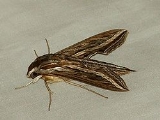
Hippotion celerio
Encyclopedia
Hippotion celerio, known as the Vine Hawk-Moth or Silver-striped Hawk-Moth, is a moth
of the Sphingidae
family. It is found in Africa
, Southern Europe
, Central and Southern Asia
and Australia
. It can be found further north, because of its migratory
nature.

Hippotion aphorodes may be only a very dark subspecies of celerio - in this form, the silvery streak on the forewing is not present but other markings are intensified. In addition, the hindwing is mainly brownish.
Larvae typically feed on the leaves of plants such as the grape vine, Cissus
, Impatiens
and the Arum
lily.
Moth
A moth is an insect closely related to the butterfly, both being of the order Lepidoptera. Moths form the majority of this order; there are thought to be 150,000 to 250,000 different species of moth , with thousands of species yet to be described...
of the Sphingidae
Sphingidae
Sphingidae is a family of moths , commonly known as hawk moths, sphinx moths and hornworms, that includes about 1,200 species . It is best represented in the tropics but there are species in every region . They are moderate to large in size and are distinguished among moths for their rapid,...
family. It is found in Africa
Africa
Africa is the world's second largest and second most populous continent, after Asia. At about 30.2 million km² including adjacent islands, it covers 6% of the Earth's total surface area and 20.4% of the total land area...
, Southern Europe
Europe
Europe is, by convention, one of the world's seven continents. Comprising the westernmost peninsula of Eurasia, Europe is generally 'divided' from Asia to its east by the watershed divides of the Ural and Caucasus Mountains, the Ural River, the Caspian and Black Seas, and the waterways connecting...
, Central and Southern Asia
Asia
Asia is the world's largest and most populous continent, located primarily in the eastern and northern hemispheres. It covers 8.7% of the Earth's total surface area and with approximately 3.879 billion people, it hosts 60% of the world's current human population...
and Australia
Australia
Australia , officially the Commonwealth of Australia, is a country in the Southern Hemisphere comprising the mainland of the Australian continent, the island of Tasmania, and numerous smaller islands in the Indian and Pacific Oceans. It is the world's sixth-largest country by total area...
. It can be found further north, because of its migratory
Lepidoptera migration
Lepidoptera migration is a biological phenomenon whereby populations of butterflies or moths migrate over long distances to areas where they cannot settle for long periods of time...
nature.

Colouring and marks
The body and forewing of the adult moth are green and ochre. They have silvery white dots and streaks, with a silvery band running obliquely on the forewing. The hindwing is red near its lower angle (tornus) to pinkish over other parts of the wing. It is crossed by a black bar and black veins.Hippotion aphorodes may be only a very dark subspecies of celerio - in this form, the silvery streak on the forewing is not present but other markings are intensified. In addition, the hindwing is mainly brownish.
Larva
Larvae may be green, yellowish green or even brown. They have a dark broken mid-dorsal line and a creamy dorso-lateral line from the fifth segment to the horn. The head is round, and usually a dull green colour. The larva has a horn which is usually long and straight. There is a large yellow and green eyespot on the third segment and a smaller one on the fourth segment.Larvae typically feed on the leaves of plants such as the grape vine, Cissus
Cissus
Cissus is a genus of approximately 350 species of woody vines in the grape family . They have a cosmopolitan distribution, though the majority are to be found in the tropics. In Tamil they are known as pirandai .-Medicinal:...
, Impatiens
Impatiens
Impatiens is a genus of about 850–1,000 species of flowering plants, widely distributed throughout the Northern Hemisphere and tropics. Together with the puzzling Hydrocera triflora, this genus makes up the family Balsaminaceae...
and the Arum
Arum
Arum is a genus of about 25 species of flowering plants in the family Araceae, native to Europe, northern Africa, and western Asia, with the highest species diversity in the Mediterranean region....
lily.

